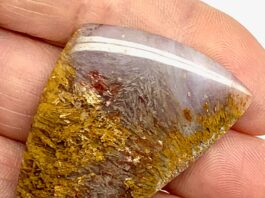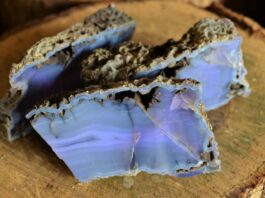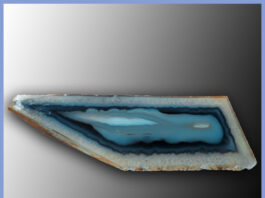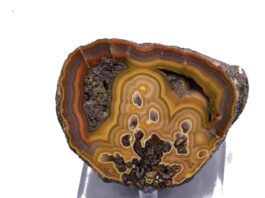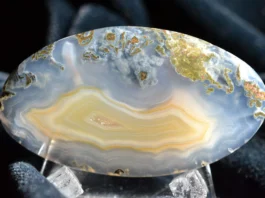Dendritic Agate is a variety of chalcedony, which is a type of microcrystalline quartz. What sets dendritic agate apart is its distinctive inclusions that create branching, tree-like patterns known as dendrites. These dendrites are typically brown to black in color and often resemble the growth of ferns or other plant-like structures, giving the stone its name.


The term “dendritic” itself is derived from the Greek word “dendron,” meaning tree. These dendritic formations are mineral deposits, usually of manganese or iron oxide, that have worked their way into the fine cracks and fissures of the agate during its formation.
It is valued for its unique and visually captivating patterns, making each piece one-of-a-kind. The base color of dendritic agate can vary widely, including shades of white, gray, blue, and even more vibrant hues. The contrast between the translucent or opaque background and the dark dendritic inclusions enhances the overall beauty of the stone.
Beyond its aesthetic appeal, dendritic agate is believed by some to possess metaphysical properties. It is often associated with grounding, stability, and connection with nature. Like other forms of agate, it is also thought to have properties that promote balance and harmony.
In addition to its use in jewelry, it is sometimes utilized in lapidary work, decorative items, and as a collectible gemstone due to its unique and captivating appearance. As with any gemstone, the value of dendritic agate is influenced by factors such as color, clarity, size, and overall aesthetic appeal.
Contents
Geological Formation of Dendritic Agate

Dendritic Agate, like other agates, forms within the cavities of rocks. The geological process leading to the formation of dendritic agate involves a combination of mineral-rich solutions, sedimentary processes, and the gradual deposition of silica. Here is a simplified explanation of the geological formation of dendritic agate:
- Cavity Formation: The process typically begins with the formation of a cavity or hollow space within a host rock. This cavity may result from a variety of geological processes, such as volcanic activity, erosion, or other forms of weathering.
- Silica Solution: Silica-rich solutions, often containing dissolved minerals, percolate through the surrounding rock. Silica is the primary component of quartz, and agate is a variety of quartz. These solutions carry the necessary materials for agate formation.
- Deposition of Silica: As the silica-rich solutions move through the cavity, they gradually deposit layers of silica on the cavity walls. The deposition occurs in concentric layers, creating the banded structure typical of agates. This process can take a long time, and each layer may have slightly different mineral compositions, leading to the characteristic banding patterns seen in agates.
- Inclusion of Dendrites: During the formation of dendritic agate, the silica solutions also carry trace amounts of minerals like manganese or iron oxide. These minerals can crystallize in dendritic patterns within the agate, creating the distinctive branching or tree-like structures.
- Coloration: The colors of dendritic agate are influenced by the presence of impurities or other minerals in the silica solutions. The base color of the agate can vary, and the contrasting dendritic inclusions often appear in shades of brown or black.
- Solidification and Hardening: Over time, the silica layers solidify and harden, forming a solid mass of agate. This process may take millions of years, depending on the geological conditions and the rate of deposition.
The result is a unique and visually stunning gemstone with dendritic inclusions embedded in a chalcedony matrix. The intricate patterns and colors of dendritic agate are a testament to the geological processes that occurred over vast periods of time.
Physical Characteristics of Dendritic Agate

Dendritic Agate exhibits several physical characteristics that contribute to its unique appearance. Here are some key features:
- Color: The base color of dendritic agate can vary widely, including shades of white, gray, blue, green, and even more vibrant colors. The coloration is influenced by the presence of impurities and trace minerals.
- Dendritic Inclusions: The most distinctive feature of it is its dendritic inclusions. These are branching or tree-like patterns that often appear in brown or black. These inclusions are mineral deposits, typically manganese or iron oxide, that have formed in a branching pattern within the agate.
- Transparency and Luster: Dendritic agate is generally translucent to opaque, and it often exhibits a waxy or vitreous luster. The transparency can vary, with some specimens allowing more light to pass through than others.
- Hardness: Like all varieties of chalcedony, has a hardness of 6.5-7 on the Mohs scale. This makes it relatively durable and suitable for use in various types of jewelry.
- Band Patterns: While dendritic inclusions are a defining characteristic, dendritic agate may also display typical banding patterns common to agate varieties. These bands can be concentric, parallel, or irregular, adding to the overall visual appeal.
- Fracture: Typically exhibits a conchoidal fracture, meaning it breaks with smooth, curved surfaces resembling the inside of a clamshell. This is a characteristic fracture pattern of many minerals with a crystalline structure.
- Specific Gravity: The specific gravity of dendritic agate ranges from 2.58 to 2.64, which is relatively low compared to some other gemstones.
- Cleavage: Dendritic agate lacks cleavage, meaning it does not break along distinct planes like minerals with cleavage.
It’s important to note that individual specimens of dendritic agate can vary widely in terms of these physical characteristics. These variations contribute to the uniqueness of each piece, making dendritic agate a sought-after gemstone for both collectors and jewelry enthusiasts.
Occurrence and Distribution of Dendritic Agate

Dendritic Agate is found in various locations around the world, and its occurrence is often associated with specific geological conditions. Here are some notable occurrences and distributions of dendritic agate:
- Brazil: Brazil is a significant source of dendritic agate, and it is known for producing high-quality specimens with vibrant colors and intricate dendritic formations. Brazilian dendritic agate is often used in jewelry and lapidary work.
- United States: It is also found in several locations in the United States, including Montana, Wyoming, and Oregon. In the Yellowstone River area of Montana, dendritic agate with moss-like inclusions is particularly famous.
- Mexico: Mexico is another country where dendritic agate is found. The state of Chihuahua is known for producing dendritic agate with striking patterns and colors.
- India: Dendritic agate deposits have been reported in India, contributing to the global supply of this gemstone.
- Madagascar: Madagascar is a known source of various gemstones, including dendritic agate. The agate from this region can exhibit unique colors and patterns.
- Germany: Germany has historically been a source of agate, including dendritic agate. The agate deposits in Germany have been known for centuries.
- Other Locations: It is also found in other locations around the world, including Australia, China, Russia, and Uruguay. Each region’s dendritic agate may have distinctive characteristics, including color variations and dendritic formations.
The formation of dendritic agate is closely tied to the geological processes that create agate in general, involving the deposition of silica-rich solutions in cavities within rocks. The presence of manganese or iron oxide in these solutions contributes to the formation of the dendritic patterns within the agate.
Collectors and lapidaries often appreciate dendritic agate not only for its geological origins but also for the variety of patterns and colors it exhibits. As with many gemstones, the specific characteristics of dendritic agate can vary based on its origin.
Dendritic Inclusions

Dendritic inclusions are intricate, tree-like or fern-like patterns formed within gemstones, and they are particularly characteristic of dendritic agate. These inclusions are not actual plant matter but mineral deposits that have crystallized in a branching or arborescent pattern. The most common minerals responsible for dendritic inclusions in dendritic agate are manganese or iron oxides.
- Cavity Formation: The process begins with the formation of a cavity or void within a host rock. This can occur through various geological processes such as volcanic activity, erosion, or other forms of weathering.
- Silica-Rich Solutions: Silica-rich solutions, carrying dissolved minerals such as manganese or iron oxide, permeate the cavity. Silica is the primary component of quartz, and agate is a variety of quartz.
- Deposition of Silica and Minerals: As these silica-rich solutions flow through the cavity, they deposit layers of silica on the cavity walls. Simultaneously, the dissolved minerals, in this case, manganese or iron oxides, are also deposited.
- Dendritic Crystal Growth: The dendritic patterns form as the manganese or iron oxide minerals crystallize in branching, tree-like structures. These formations grow outward from a central point, creating intricate and delicate patterns resembling plant growth.
- Coloration: The color of the dendritic inclusions is often brown or black, providing a stark contrast to the lighter-colored agate matrix. The specific color can depend on the type of minerals present and their oxidation states.
- Solidification: Over time, the silica layers and dendritic inclusions solidify, resulting in the hard, compact structure characteristic of agate.
The term “dendritic” is derived from the Greek word “dendron,” meaning tree, reflecting the tree-like appearance of these inclusions. The unique beauty of dendritic agate, with its captivating patterns resembling natural landscapes or organic structures, has made it a popular choice in jewelry and lapidary arts. The individuality of each dendritic agate specimen, with its distinctive dendritic inclusions, adds to its value and appeal.
Uses and Applications

Dendritic Agate is valued for its unique appearance and has various uses and applications:
- Jewelry: One of the primary uses of dendritic agate is in jewelry. It is often cut and polished into cabochons for use in rings, pendants, earrings, and other forms of jewelry. The distinctive dendritic patterns and a wide range of colors make dendritic agate an attractive and eye-catching gemstone.
- Lapidary Art: Dendritic agate is popular among lapidaries and artisans who work with gemstones. It can be carved into decorative items, beads, and cameos, showcasing the intricate dendritic inclusions.
- Collectibles: Dendritic agate, especially specimens with unique and striking patterns, is often collected by gemstone enthusiasts and collectors. The individuality of each piece, with its distinct dendritic formations, adds to its appeal as a collectible item.
- Metaphysical and Spiritual Uses: Some individuals believe in the metaphysical properties of dendritic agate. It is associated with grounding, stability, connection with nature, and balance. People may use dendritic agate as a gemstone for meditation, energy work, or as a talisman.
- Home Décor: Dendritic agate, especially larger specimens, can be used as decorative items in homes or offices. Displaying dendritic agate in its natural form or as polished pieces can add a touch of natural beauty to interior spaces.
- Gifts: Dendritic agate jewelry or polished specimens can make unique and thoughtful gifts due to their individuality and visual appeal. The dendritic patterns often evoke a sense of nature and can have personal significance for the recipient.
- Art and Craft Projects: Dendritic agate can be incorporated into various art and craft projects. Its unique patterns can inspire creativity, and smaller pieces or beads can be used in a variety of artistic endeavors.

It’s important to note that while dendritic agate has cultural and metaphysical associations, its uses are primarily aesthetic and ornamental. As with any gemstone, individual preferences, beliefs, and cultural significance can influence how people choose to use and appreciate dendritic agate.


